Being a digitally enabled leader means (1) developing capabilities to generate insights from data, (2) leverage the cloud, and (3) build a skilled and enabled workforce.
This is an excerpt of the publication below, with the title above, focusing on the related topic.
The Keys to Scaling Digital Value
MARCH 16, 2022
By Karalee Close, Marc Roman Franke, Michael Grebe, Hrishi Hrishikesh, and Kristi Rogers
BCG commissioned by GOOGLE
The Capabilities That Enable Scaling
Our client work and our research have consistently shown that companies need critical capabilities in place to scale digital solutions.
Being a digitally enabled leader means developing capabilities to generate insights from data, leverage the cloud, and build a skilled and enabled workforce.
Being a digitally enabled leader means developing capabilities to generate insights from data, leverage the cloud, and build a skilled and enabled workforce.
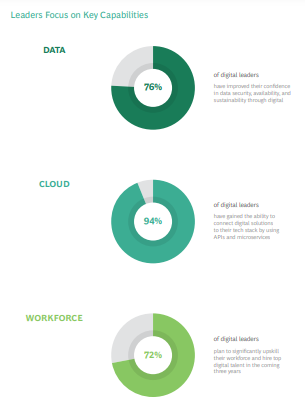
Generating Insights from Data
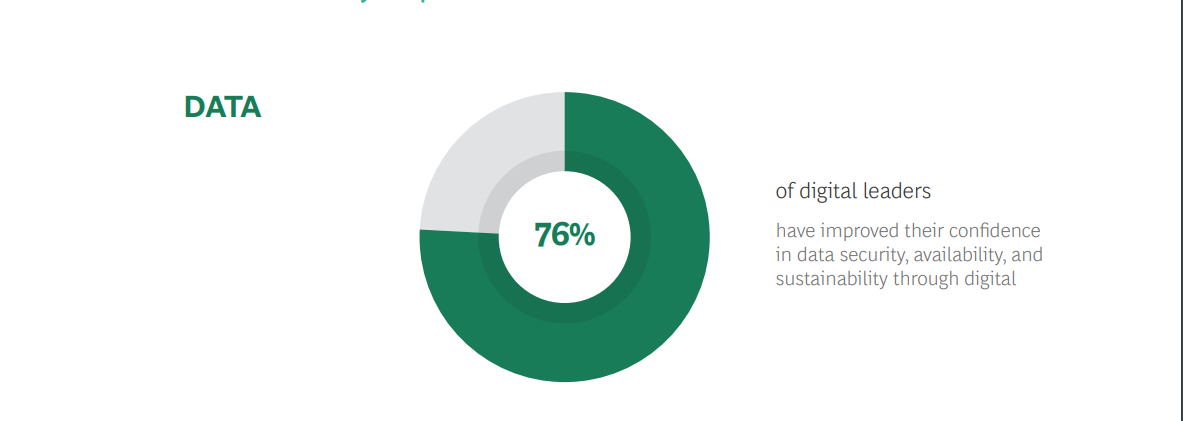
The ability to access high-quality data from multiple sources, share it with partner organizations, and apply advanced analytics to generate insights for long-term impact is a multipurpose enabler for everything else.
Data enablement is the most important basis of competitive advantage today because it has the greatest impact on a company’s ability to scale digital solutions. Nevertheless, in most organizations, it is the least exploited asset.
Even among digital leaders, those with the highest data maturity can scale twice as many solutions as those with relatively low data enablement.
To be a data leader, companies need privacy-compliant, high-quality data that is accessible throughout the organization.
This requires strong data governance, proper data infrastructure, and respect for customers’ demands for privacy. (See Exhibit 6.)
The ability to access high-quality data from multiple sources, share it with partner organizations, and apply advanced analytics to generate insights for long-term impact is a multipurpose enabler for everything else

To be a data leader, companies need privacy-compliant, high-quality data that is accessible throughout the organization.
This requires strong data governance, proper data infrastructure, and respect for customers’ demands for privacy.
Companies should prioritize and manage data proficiency much as they do infrastructure, with forward-looking investment and a fully funded investment plan.
Accessibility is key, and tapping into data-sharing enablers, such as cloud services, helps organizations ensure access to high-quality data from different business ecosystems.
This kind of data leads to superior insights and customer engagement as well as the ability to scale digital solutions.
Companies should prioritize and manage data proficiency much as they do infrastructure, with forward-looking investment and a fully funded investment plan. Accessibility is key …
Proper data governance underpins access to accurate and useful data. Digital leaders combine effective data ownership and governance procedures, which help ensure that a continuing supply of high-quality data is available and that people use the data appropriately and consistently. Many common challenges such as data breaches occur not because of technological shortfalls but because of human error.
Proper data governance underpins access to accurate and useful data.
Most digital leaders build future-ready architectures with data repositories and API provisioning, and many operate data ecosystems with multiple partners.
In fact, our research found that 60% of digital leaders have mature infrastructure in place to facilitate the seamless exchange of real-time data with partners.
In contrast, most laggards are still building their data infrastructure and have no data governance in place.
Most digital leaders build future-ready architectures with data repositories and API provisioning, and many operate data ecosystems with multiple partners.
… 60% of have mature infrastructure in place to facilitate the seamless exchange of real-time data with partners.
Data also needs to be portable -decoupled from, rather than restricted to, specific applications.
The idea is to create pools of shared data from which users, applications, and partners can leverage the same information, instead of vertical data islands.
Hoarding data limits insights and value creation to a small sliver of what might otherwise be possible, and different underlying architectures and technologies lead to vertical data silos.
Such data silos can be deceptively attractive, since they may facilitate implementation of solo digital solutions. But at the same time, they limit the ability to scale solutions across the wider business unit or company.
Data also needs to be portable -decoupled from, rather than restricted to, specific applications.
A leading agricultural equipment manufacturer sought to become a tech leader by improving its use of data. It collected accurate, real-time data by attaching sensors to its products so it could provide richer information to growers and optimize performance of its products. The company also developed an open platform with modern architecture to consolidate data collected from customers and external partners. The platform enables farmers to use advanced data analytics tools to manage their equipment better and realize cost and operational efficiencies while also connecting with players throughout the agricultural ecosystem.
The new data strategy gave farmers a superior customer experience and provoked a data-driven revolution within the company and the agricultural equipment industry. To successfully scale this solution, the company had to make the transition from being an equipment manufacturer to being a generator and custodian of data. In the second quarter of 2021, net sales and operating profit from its production and agricultural business increased by more than 35% and 75%, respectively, over the year-earlier quarter.
One of the biggest drivers of digital maturity is the use of first-party data — data that companies collect directly from consumers, including browsing behavior, transaction history from a CRM database, and loyalty program activity.
Sophisticated companies understand that first-party data is differentiating (because it is proprietary), relevant (it directly relates to the company and its customers), and consistently high quality (it comes from customers directly).
Almost 50% of leaders use first-party data to derive insights that create better customer value propositions, but just 5% of laggards do. Previous BCG research found that while nine out of ten companies say that first-party data is important to their digital marketing programs, less than a third of marketers consistently and effectively access and integrate first-party data across channels. Very few are good at using data to create better outcomes for customers.
A global cosmetics brand that wanted to use data and technology to accelerate growth faced challenges related to poor data availability and a lack of necessary technology capabilities.
Using public cloud services, the company developed an enterprise-wide data strategy that focused on using its own first-party data to target audiences better. For example, the new model customized marketing for website visitors identified as most likely to purchase online. The company also increased data accessibility and analytics proficiency throughout the organization and encouraged data-driven innovation. The strategy enabled the company to increase revenues from campaigns using data-driven insights by 25% and to scale its data solutions globally within two years. It also helped the company build an organization-wide culture that appreciates and seeks to leverage the value of data and analytics.
Leaders also prioritize data privacy because it is a priority for customers. One common challenge that companies face in making data more accessible is increased data risk. Properly identifying, assessing, and managing risk through shared platforms is a strong driver of security. Almost all digital leaders (97%) are proficient in addressing this risk, and more than two-thirds of leaders make effectively managing it a C-suite priority.
Leaders also prioritize data privacy because it is a priority for customers.
Leveraging the Cloud
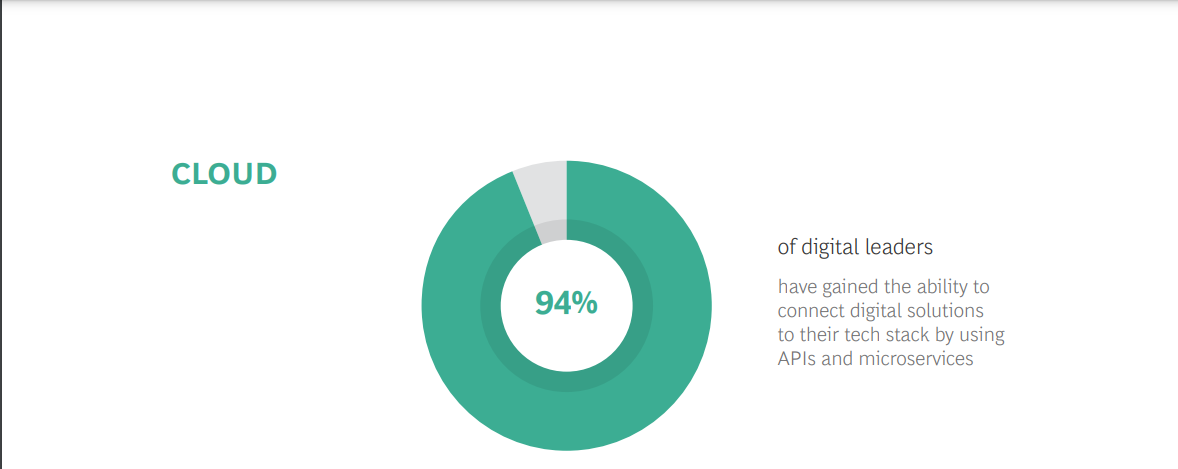
To power their scaling of digital solutions, leaders use the cloud, which serves as a technological foundation for building and expanding other enablers, such as data.
Most leaders (64%) design solutions to be cloud native so that the cloud can host every new digital solution right away. (See Exhibit 7.)
Leaders deploy these solutions in a layered architecture connected with APIs and, often, employing two or more clouds.
A multicloud approach delivers a number of benefits, including increased agility, greater flexibility, higher innovation rates, and the ability to deploy cutting-edge technology and platform strengths from various providers.
This approach decouples digital delivery from legacy systems, which in turn enables easier testing, deployment, and maintenance. Digital leaders also reduce the costs of digital scaling.
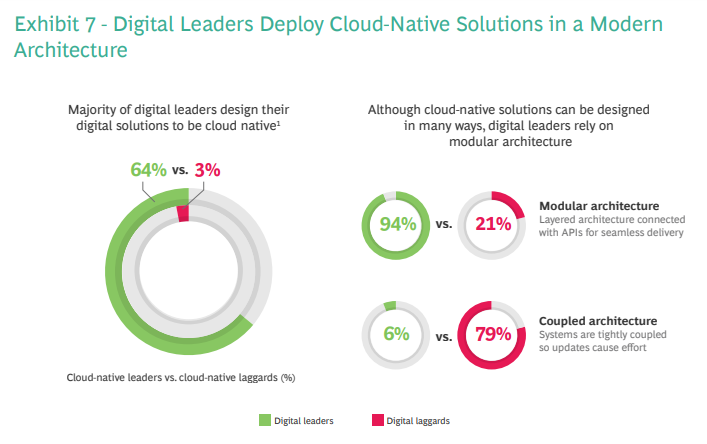
To power their scaling of digital solutions, leaders use the cloud, which serves as a technological foundation for building and expanding other enablers, such as data.
A multicloud approach delivers a number of benefits, including increased agility, greater flexibility, higher innovation rates, and the ability to deploy cutting-edge technology and platform strengths from various providers.
By 2025, up to 60% of consumer-facing applications, almost 40% of data warehouses and analytics workloads, and more than 30% of core business applications will be running on public clouds that major technology organizations operate.
More than 90% of digital leaders can connect digital solutions to their tech stacks, which are API ready and use microservices.
In contrast, 80% of laggards still rely on tightly coupled legacy systems with complex interfaces.
By 2025, up to 60% of consumer-facing applications, almost 40% of data warehouses and analytics workloads, and more than 30% of core business applications will be running on public clouds that major technology organizations operate.
Three factors make the cloud a powerful booster of digital capabilities:
- The cloud permits instant scaling of tech capacity (infrastructure, storage, and processing).
- Solutions provided by cloud service providers (CSPs) usually include the latest cybersecurity mechanisms and patches.
- CSPs have the expertise and people-both of which are in short supply-to customize solutions for clients efficiently.
Although the cloud can function as a supercharger for scaling digital solutions, controlling its cost is a key consideration, as is complying with national regulations and data governance requirements.
Companies have followed multiple paths to mainstream cloud adoption. Decisions about which capabilities to move to the cloud when to move them, and which cloud service models to use do not always follow a deliberate strategy.
As a result, clarity on what constitutes an efficient and effective multicloud approach can be hard to come by. It is therefore not surprising that only one in three companies controls cloud costs.
But 68% of digital leaders reported that they optimize cloud spending with advanced cost analyses. In doing so, they realize two to three times more cost efficiency and tech cost savings than laggards do. (See Exhibit 8.)

68% of digital leaders reported that they optimize cloud spending with advanced cost analyses.
A satellite imagery provider needed to redesign its imagery platform for scale and speed to meet growing customer needs and to sharply reduce a delay of several hours that customers trying to access images had to endure.
The company moved to a cloud-based platform that gave customers data after minimal delay, without compromising on quality or range of coverage. The cloud platform scaled data better, processed images faster, and provided more fit-for-purpose images for different customer groups. Customers can now stream images after a half-second delay compared with the old system’s wait of hours or even days. The cloud also gives the company a scalable storage solution for adding images covering millions of square kilometers every week.
Building a Skilled and Enabled Workforce
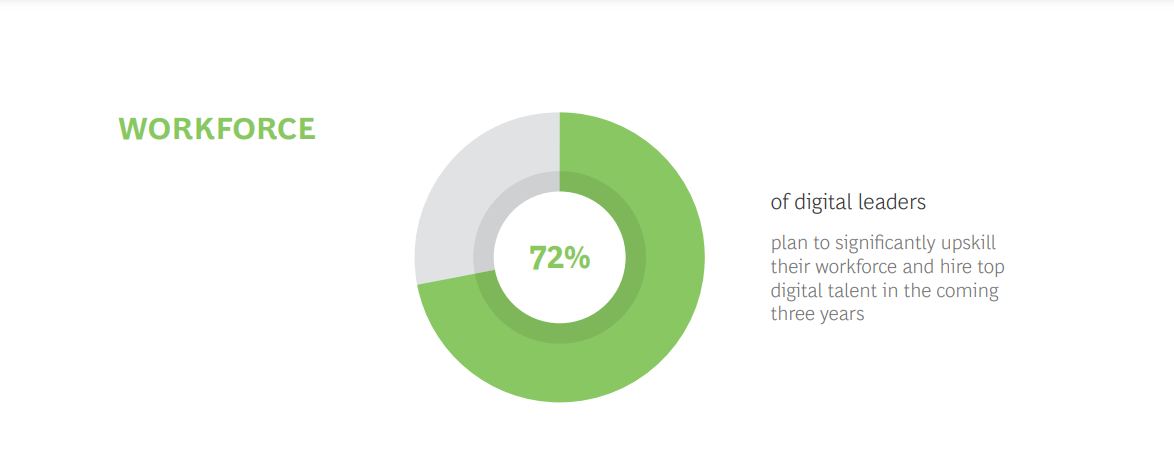
Digital leaders build highly skilled organizations through upskilling and targeted recruitment to fill talent gaps.
BCG research into the factors underlying digital transformation success found that only one in four organizations have the skills and expertise they need.
Our current study found that digital leaders are addressing this gap at speed through their hiring and training plans.
Leading organizations also equip teams with technology tools such as productivity apps, DevOps (a type of continuous software development and IT operation), and AI analytics to make the most of their capabilities and to innovate and drive change.
Reorganizing in cross-functional teams that include business, digital, tech, and other functional skills (such as HR, legal, and finance) is also critical.
Digital leaders build highly skilled organizations through upskilling and targeted recruitment to fill talent gaps. … digital leaders are addressing this gap at speed through their hiring and training plans.
Reorganizing in cross-functional teams that include business, digital, tech, and other functional skills (such as HR, legal, and finance) is also critical.
Digital leaders do not try to do everything in-house. Instead, where they can, they outsource capabilities-such as tapping into public cloud platforms-to drive to scale more quickly.
Because many digital skills (such as DevOps) are in high demand, leading organizations choose strategic partners to fill skills gaps and embed partner personnel in their product teams.
Many companies adopt a hybrid approach, developing the critical capabilities they need to innovate in-house and filling the remaining skills gap through partnerships.
Leaders that scale solutions successfully through outsourcing to partners and agencies generate 20% more cost savings and 20% higher revenue growth than laggards.
Digital leaders do not try to do everything in-house. Instead, where they can, they outsource capabilities-such as tapping into public cloud platforms-to drive to scale more quickly.
Leaders that scale solutions successfully through outsourcing to partners and agencies generate 20% more cost savings and 20% higher revenue growth than laggards.
Almost half of the leaders say that the expertise of their workforce is significantly greater than that of their peers because they have built best-in-class capabilities, such as developing cloud-native apps and optimizing user experience through personalization, and because they rely on cross-functional teams.
But this finding also means that more than half of leaders do not see their workforce’s expertise as being significantly above that of their peers.
They recognize that they still have a strong need for talent and organizational development. Little surprise, then, that 72% of leaders plan significant HR investments to hire and upskill their workforce.
Little surprise, then, that 72% of leaders plan significant HR investments to hire and upskill their workforce.
Leaders also foster a culture of innovation through data-driven decision making and rapid adaptation.
More than three times more leaders than laggards democratize data, institutionalizing data accessibility for all.
Many leaders charge an empowered chief data officer with embedding data-sharing policies through the organization and enforcing good data governance and practices.
These companies also promote a strong learning culture by prioritizing digital literacy and agile ways of working.
And they organize around a product-led operating model to realize economies of scale and scope: teams are responsible for client engagement, innovation, and service delivery.
Little surprise, then, that 72% of leaders plan significant HR investments to hire and upskill their workforce.
A leading US health insurance company decided to pivot to a product-led operating model to upgrade its customers’ experience and improve their health outcomes.
The company had based its prior operating model on functional needs that emphasized efficiencies, but the company struggled to retain customers over the longer term because members found the organization difficult to navigate. To provide a more seamless experience for customers, the company moved from siloed operations to collaborative, cross-functional teams. These integrated teams identified key customer pain points and built solutions that drew support from all parts of the organization. The cross-functional teams also encouraged greater accountability, more innovation, and accelerated time to market for new services. The teams launched 18 new customer experiences and created $50 million of customer lifetime value (a metric that estimates how much value any given customer will bring to a business) in the first six months alone.
Originally published at: https://www.bcg.com












